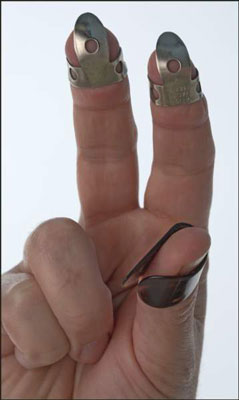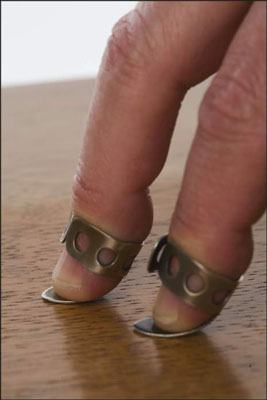Like thumbpicks for banjo playing, metal fingerpicks consist of a blade-shaped striking surface joined to a collar that holds the fingerpick around the end of the finger. You want to fit the picks on your index and middle fingers so that the striking surface is on the opposite side of your hand from your fingernail (as shown).

You can find many different kinds of fingerpicks on the market today (you can have a look at a few of them in this Figure). They vary in size and thickness and also in metal composition. Some fingerpicks have more of a curved striking surface while others have a flat blade. Some have holes in them and others don't.
Experiment with different fingerpicks to see which ones fit the most comfortably and — most importantly — sound the best to you.
Fingerpicks range in price from $3 a pair to $35 for a pair of handcrafted, stainless-steel picks. Look for metal fingerpicks from Propik, National, Dunlop, Showcase 41, and Sammy Shelor, among others, for the tone preferred by bluegrass players.
![Comparing different kinds of fingerpicks. [Credit: Photograph by Anne Hamersky]](https://www.dummies.com/wp-content/uploads/417930.image1.jpg)
You need to bend the fingerpicks to get a good fit, because they don't usually come straight from the store ready to use without modification. Here's how you do it:
Place the pick on the end of your finger with the collar placed between the end of the finger and the first joint.
Don't place the collar at the joint itself because that's too far up the finger.
Grasp either side of the collar with your left-hand thumb and index finger and squeeze it so that the fit is snug but not too tight on the end of your finger.
Remember that you want the blade of the pick extending just past the end of your finger. If your pick fits well, you can stop here, but most players also like to bend the blade back a bit to match the natural curve of the end of the finger.
If your pick isn't too heavy, you should be able to successfully bend the blade by pushing down on the pick against a tabletop or another hard surface (as shown).
 Credit: Photograph by Anne HamerskyHow to adjust the bend of the fingerpick blade by pushing on a tabletop.
Credit: Photograph by Anne HamerskyHow to adjust the bend of the fingerpick blade by pushing on a tabletop.
One last modification that some players make to their fingerpicks is that they fit the pick on the finger at a slight angle, so that when the finger strikes the banjo string, the pick meets the string at a straighter, or more parallel, angle.
This modification can result in a fuller, more-pleasing tone as well as added volume. You don't need to worry about this right now, but you may want to try angling the fingerpick as you gain more experience playing.

